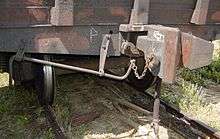SA3 coupler
Click here for animation



The SA3 coupler is a type of railway coupling used mainly, but not exclusively, in Russia and other states of the former Soviet Union.[1]
Railways in Russia used European (British) buffers and chain couplings from their inception. These couplings had three main limitations. Firstly the load was limited. Secondly, the couplings were not semi-automatic like the North American Janney AAR coupler. Thirdly, the buffers could get buffer-locked and cause accidents. Advantages and disadvantages of these couplings are intermediate between Janney AAR couplers and Scharfenberg couplers.
It took a while to find a replacement. One option was to copy the Janney AAR coupling, as Japan (1922), Australia (1915) and other countries were starting to do, or to devise something else.
The Willison coupler was patented by John Willison from Derby, England.[2][3] It was registered in 1910, and approved in USA 1916, and in Germany. The company Knorr bought it and it started to be used in Germany for some heavy trains and some suburban trains in Paris. The Soviet Union needed a new coupler and decided to use this coupler.
Experimentation
In the late 1920s, the UIC had established a working group for the replacement of the chain link coupler, which restricts the efficiency of freight railroads in a major way. Many railroads ran prototypes. In Germany, coal trains with Scharfenberg couplers yielded unfavourable results in winter weather, other railroads did similar tests. But the UIC was not able to agree on one replacement. This failure of the UIC, which hampers freight operation in Europe even today, led to the decision by the Soviet Union to move forward without a standard being achieved in the talks.
The coupler was developed in (1932) and named SA-3 (abbreviation of Russian Советская автосцепка, 3-й вариант, Soviet Automatic-Coupler 3rd Variant) and was an improved version of Willison coupler, with better design of lock parts and mechanics. In 1935, the conversion of the vehicles began gradually. The Second World War delayed the introduction, so that the conversion was completed only 1957.
Operation of this coupler
Helper locomotives at the end of the train are rarely used in the countries of the former Soviet Union. The load of the freight per train is not as heavy as on American railways.
Although the SA-3 coupler is primarily used in the countries of the former Soviet Union, they are visible every day at the transshipping stations, at the eastern borders of the European Union (Poland, Slovakia and Hungary). Since bogie-changing technology has progressed, this allows for cars with SA-3 coupler to regularly operate on the standard gauge tracks. A special converter car is inserted between standard and broad gauge cars for this operation, with different couplers (SA-3 and standard) on either end. Although these coupling freight cars (light blue coloured at the Slovak Cargo Railways) have room for cargo, they are always operated empty.
If the vehicle fitted with the SA3 retains its buffers, then a special adapter allows that vehicle to couple to another vehicle fitted with buffers and chains, provided that the buffers have the same spacing or gauge. This appears to be done in Iran.
On the Uzhhorod–Košice broad-gauge track between Košice and Uzhhorod, Ukraine, of which the major part is on Slovakian territory, SA3 couplings are used exclusively. The railway is used for ore and coal transports from Kryvyi Rih, Ukraine to the US Steel mill in Košice and coal to the power plant of Vojany.
In addition, the heavy iron ore trains on the Swedish Malmbanan began to use SA3 couplings in 1969 after problems with snapping chain couplers and a need for ever increasing capacity with higher train weights. Today, IORE locomotives haul trains of 68 hopper cars of 120 tonnes (120 long tons; 130 short tons) with a total weight of over 8,000 tonnes (7,900 long tons; 8,800 short tons) over gradients of 10 per-mille (1%) in harsh weather conditions, from the LKAB mine in Kiruna to the ice-free harbour of Narvik, Norway using couplings of the SA3 type without any problem. They tried out Janney couplers, too, when moving beyond 8,000 tons because SA-3 hasn't seen much use at such loads before that: in the SU, freight trains rarely exceeded 6,000 tons. The earlier SJ Dm3 locomotives have buffers fitted; therefore, they can couple with cars (or locomotives for transportation purposes) with a chainlink coupler.
The longest and heaviest train with SA3 couplings ran on 20 February 1986 from Ekibastuz to the Urals, Soviet Union. The composition consisted of 439 coal wagons and several diesel locomotives distributed along the train with a mass of 43,400 tonnes and the total length of 6.5 kilometres (4.0 mi).[4]
Future
The new European Automatic Center Coupler (C-AKv)[5] has been based on this coupler, with the extended features of automatic brake and electric couplings. It also has vertical stability added, so that the coupling cannot fall down and damage the tracks or cause a derailment. It is compatible with the standard SA3 coupler and will have buffers needed for use with the standard buffers and chain couplers under the long transition period. The electric plugs would be most useful with electronically controlled pneumatic brakes.
Usage
The former Soviet Union:
-
 Armenia, Armenian Railways
Armenia, Armenian Railways -
 Azerbaijan, Azerbaijan Railways
Azerbaijan, Azerbaijan Railways -
 Belarus, Belarusian Railway
Belarus, Belarusian Railway -
 Estonia, Eesti Raudtee
Estonia, Eesti Raudtee -
 Georgia, Georgian Railways
Georgia, Georgian Railways -
 Kazakhstan, Kazakhstan Temir Zholy
Kazakhstan, Kazakhstan Temir Zholy -
 Kyrgyzstan, Kyrgyz Railways
Kyrgyzstan, Kyrgyz Railways -
 Latvia, Latvian Railways
Latvia, Latvian Railways -
 Lithuania, Lithuanian Railways
Lithuania, Lithuanian Railways -
 Moldova, Calea Ferată din Moldova
Moldova, Calea Ferată din Moldova -
 Russia, Russian Railways
Russia, Russian Railways -
 Turkmenistan, Türkmendemirýollary
Turkmenistan, Türkmendemirýollary -
 Tajikistan, Rail transport in Tajikistan
Tajikistan, Rail transport in Tajikistan -
 Ukraine, Ukrainian Railways
Ukraine, Ukrainian Railways -
 Uzbekistan, Uzbek Railways
Uzbekistan, Uzbek Railways
Other countries with extensive usage
-
 Finland, Rail transport in Finland
Finland, Rail transport in Finland -
 Mongolia, Rail transport in Mongolia
Mongolia, Rail transport in Mongolia -
 Iraq, Iraqi Republic Railways
Iraq, Iraqi Republic Railways -
 Turkey, Rail transport in Turkey
Turkey, Rail transport in Turkey -
 Mauritania Railway operated by Société Nationale Industrielle et Minière
Mauritania Railway operated by Société Nationale Industrielle et Minière -
 Cameroon, Camrail
Cameroon, Camrail -
 Gabon, Trans-Gabon Railway (called Willison coupler)
Gabon, Trans-Gabon Railway (called Willison coupler)
Some usage
-
 Sweden &
Sweden &  Norway (Malmbanan/Ofotbanen); Used exclusively by heavy iron-ore trains.
Norway (Malmbanan/Ofotbanen); Used exclusively by heavy iron-ore trains. -
 Australia; Miniature SA3 used on some sugarcane tramways and underground colliery railways.
Australia; Miniature SA3 used on some sugarcane tramways and underground colliery railways. -
 Slovakia (Uzhhorod–Košice broad-gauge track); Heavy iron-ore transports from Ukraine.
Slovakia (Uzhhorod–Košice broad-gauge track); Heavy iron-ore transports from Ukraine. -
 Poland (Broad Gauge Metallurgy Line); The longest broad gauge railway line in Poland. It is used only for freight traffic, mainly iron ore and coal.
Poland (Broad Gauge Metallurgy Line); The longest broad gauge railway line in Poland. It is used only for freight traffic, mainly iron ore and coal. -
 United States Willson Coupler used in mining and tunneling railroads.[6]
United States Willson Coupler used in mining and tunneling railroads.[6]
See also
- C-AKv coupler
- Draft gear
- Heaviest trains of 30,000 short tons (27,216 t; 26,786 long tons) use Janney AAR couplers.
- Intermat coupler
- Longest trains of 2.5 km (1.6 mi)
- Railway coupling by country
- Unicoupler/Intermat
